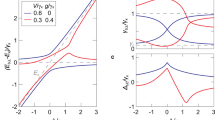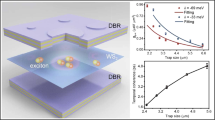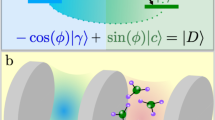Abstract
The strong coupling of excitons to optical cavities has provided new insights into cavity quantum electrodynamics as well as opportunities to engineer nanoscale light–matter interactions1,2,3,4,5,6. Here we study the interaction between out-of-equilibrium cavity photons and both neutral and negatively charged excitons, by embedding a single layer of the atomically thin semiconductor molybdenum diselenide in a monolithic optical cavity based on distributed Bragg reflectors. The interactions lead to multiple cavity polariton resonances and anomalous band inversion for the lower, trion-derived, polariton branch—the central result of the present work. Our theoretical analysis reveals that many-body effects in an out-of-equilibrium setting result in an effective level attraction between the exciton-polariton and trion-polariton accounting for the experimentally observed inverted trion-polariton dispersion. Our results suggest a pathway for studying interesting regimes in quantum many-body physics yielding possible new phases of quantum matter7,8,9,10,11 as well as fresh possibilities for polaritonic device architectures12,13,14,15.
This is a preview of subscription content, access via your institution
Access options
Access Nature and 54 other Nature Portfolio journals
Get Nature+, our best-value online-access subscription
$32.99 / 30 days
cancel any time
Subscribe to this journal
Receive 12 print issues and online access
$259.00 per year
only $21.58 per issue
Buy this article
- Purchase on SpringerLink
- Instant access to full article PDF
Prices may be subject to local taxes which are calculated during checkout




Similar content being viewed by others
References
Kavokin, A. V., Baumberg, J. J., Malpuech, G. & Laussy, F. P. Microcavities (Oxford Science Publication, 2007).
Gibbs, H. M., Khitrova, G. & Koch, S. W. Exciton-polariton light-semiconductor coupling effects. Nat. Photon. 5, 273 (2011).
Weisbuch, C., Nishioka, M., Ishikawa, A. & Arakawa, Y. Observation of the coupled exciton-photon mode splitting in a semiconductor quantum microcavity. Phys. Rev. Lett. 69, 3314–3317 (1992).
Pau, S., Björk, G., Jacobson, J., Cao, H. & Yamamoto, Y. Microcavity exciton-polariton splitting in the linear regime. Phys. Rev. B 51, 14437–14447 (1995).
Lidzey, D. G. et al. Strong exciton–photon coupling in an organic semiconductor microcavity. Nature 395, 53–55 (1998).
Hennessy, K. et al. Quantum nature of a strongly coupled single quantum dot–cavity system. Nature 445, 896–899 (2007).
Balili, R., Hartwell, V., Snoke, D., Pfeiffer, L. & West, K. Bose–Einstein condensation of microcavity polaritons in a trap. Science 316, 1007–1010 (2007).
Deng, H., Haug, H. & Yamamoto, Y. Exciton-polariton Bose–Einstein condensation. Rev. Mod. Phys. 82, 1489–1537 (2010).
Plumhof, J. D., Stöferle, T., Mai, L., Scherf, U. & Mahrt, R. F. Room-temperature Bose–Einstein condensation of cavity exciton-polaritons in a polymer. Nat. Mater. 13, 247–252 (2013).
Byrnes, T., Kim, N. Y. & Yamamoto, Y. Exciton-polariton condensates. Nat. Phys. 10, 803–813 (2014).
Smolka, S. et al. Cavity quantum electrodynamics with many-body states of a two-dimensional electron gas. Science 346, 332–335 (2014).
Deng, H., Weihs, G., Snoke, D., Bloch, J. & Yamamoto, Y. Polariton lasing vs. photon lasing in a semiconductor microcavity. Proc. Natl Acad. Sci. USA 100, 15318–15323 (2003).
Tsintzos, S. I., Pelekanos, N. T., Konstantinidis, G., Hatzopoulos, Z. & Savvidis, P. G. A GaAs polariton light-emitting diode operating near room temperature. Nature 453, 372–375 (2008).
Ballarini, D. et al. All-optical polariton transistor. Nat. Commun. 4, 1778 (2013).
Cerna, R. et al. Ultrafast tristable spin memory of a coherent polariton gas. Nat. Commun. 4, 2008 (2013).
Savvidis, P. G. et al. Angle-resonant stimulated polariton amplifier. Phys. Rev. Lett. 84, 1547–1550 (2000).
Kéna-Cohen, S. & Forrest, S. R. Room-temperature polariton lasing in an organic single-crystal microcavity. Nat. Photon. 4, 371–375 (2010).
Das, A. et al. Room temperature ultralow threshold GaN nanowire polariton laser. Phys. Rev. Lett. 107, 066405 (2011).
Schneider, C. et al. An electrically pumped polariton laser. Nature 497, 348–352 (2013).
Rapaport, R., Cohen, E., Ron, A., Linder, E. & Pfeiffer, L. N. Negatively charged polaritons in a semiconductor microcavity. Phys. Rev. B 63, 235310 (2001).
Flatten, L. C. et al. Strong exciton–photon coupling with colloidal nanoplatelets in an open microcavity. Nano Lett. 16, 7137–7141 (2016).
Wang, Q. H., Kalantar-Zadeh, K., Kis, A., Coleman, J. N. & Strano, M. S. Electronics and optoelectronics of two-dimensional transition metal dichalcogenides. Nat. Nanotech. 7, 699–712 (2012).
Mak, K. F. et al. Tightly bound trions in monolayer MoS2 . Nat. Mater. 12, 207–211 (2012).
Chakraborty, C., Kinnischtzke, L., Goodfellow, K. M., Beams, R. & Vamivakas, A. N. Voltage-controlled quantum light from an atomically thin semiconductor. Nat. Nanotech. 10, 507–511 (2015).
Ramasubramaniam, A. Large excitonic effects in monolayers of molybdenum and tungsten dichalcogenides. Phys. Rev. B 86, 115409 (2012).
Ugeda, M. M. et al. Giant bandgap renormalization and excitonic effects in a monolayer transition metal dichalcogenide semiconductor. Nat. Mater. 13, 1091–1095 (2014).
Liu, X. et al. Strong light–matter coupling in two-dimensional atomic crystals. Nat. Photon. 9, 30–34 (2014).
Dufferwiel, S. et al. Exciton-polaritons in van der Waals heterostructures embedded in tunable microcavities. Nat. Commun. 6, 8579 (2015).
Sidler, M. et al. Fermi polaron-polaritons in charge-tunable atomically thin semiconductors. Nat. Phys. 13, 255–261 (2016).
Sich, M. et al. Observation of bright polariton solitons in a semiconductor microcavity. Nat. Photon. 6, 50–55 (2011).
Ross, J. S. et al. Electrical control of neutral and charged excitons in a monolayer semiconductor. Nat. Commun. 4, 1474 (2013).
Lundt, N. et al. Valley polarized relaxation and upconversion luminescence from Tamm-plasmon trion-polaritons with a MoSe2 monolayer. 2D Mater. 4, 025096 (2017).
Acknowledgements
This work was supported by NSF EFRI EFMA-1542707, NSF CAREER DMR 1553788, AFOSR FA9550-16-1-0020 and the University of Rochester University Research Award and the Leonard Mandel Faculty Fellowship in Quantum Optics. S.D. also acknowledges support from a Ramanujan Fellowship research grant, SERB, and ISIRD project SRIC, IIT Kharagpur. S.B. acknowledges the Max-Planck-Gesellschaft for funding though MPI partner group at ICTS.
Author information
Authors and Affiliations
Contributions
S.D., C.C., K.M.G., T.A.O’L., G.W.W. and A.N.V. conceived the research. S.D., C.C., T.A.O’L. and K.M.G. fabricated the samples. S.D., C.C. and L.Q. conducted the measurements. S.D., C.C., S.B. and A.N.V. devised the theoretical model. All authors discussed the data and wrote the manuscript.
Corresponding author
Ethics declarations
Competing interests
The authors declare no competing financial interests.
Supplementary information
Supplementary information
Supplementary information (PDF 423 kb)
Rights and permissions
About this article
Cite this article
Dhara, S., Chakraborty, C., Goodfellow, K. et al. Anomalous dispersion of microcavity trion-polaritons. Nat. Phys. 14, 130–133 (2018). https://doi.org/10.1038/nphys4303
Received:
Accepted:
Published:
Issue date:
DOI: https://doi.org/10.1038/nphys4303
This article is cited by
-
Intercavity polariton slows down dynamics in strongly coupled cavities
Nature Communications (2024)
-
Negative-mass exciton polaritons induced by dissipative light-matter coupling in an atomically thin semiconductor
Nature Communications (2023)
-
Observation of Bragg polaritons in monolayer tungsten disulphide
Nano Research (2022)
-
Valley-selective optical Stark effect of exciton-polaritons in a monolayer semiconductor
Nature Communications (2021)
-
Interferometric control of magnon-induced nearly perfect absorption in cavity magnonics
Nature Communications (2021)



